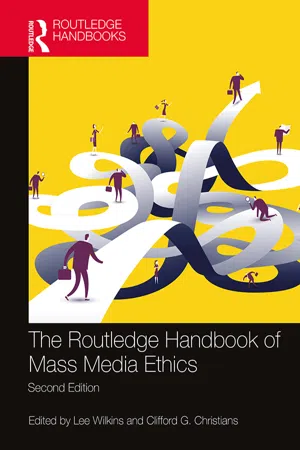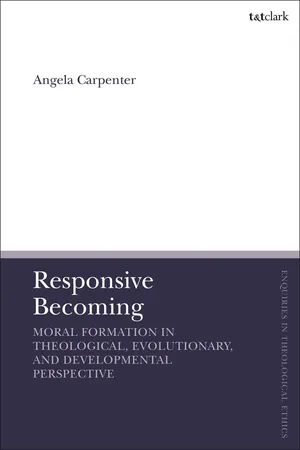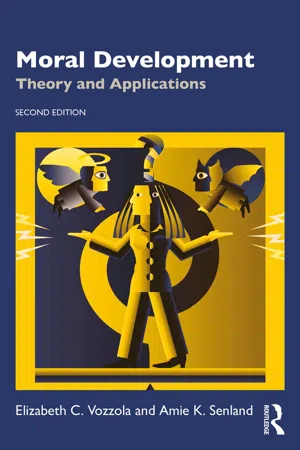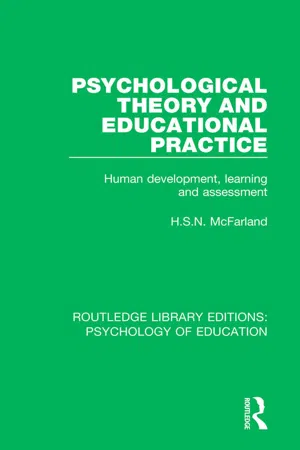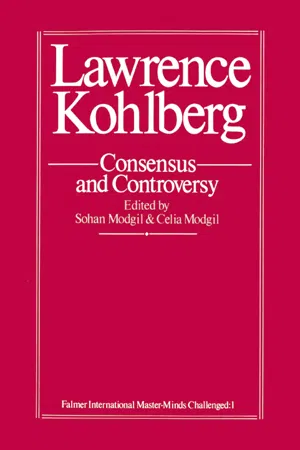Psychology
Moral Development in Childhood
Moral development in childhood refers to the process through which children acquire an understanding of right and wrong, as well as develop a sense of empathy and responsibility towards others. This development is influenced by factors such as parenting, social interactions, and cognitive development. Key theorists in this area include Jean Piaget and Lawrence Kohlberg, who proposed stages of moral development that children progress through.
Written by Perlego with AI-assistance
Related key terms
8 Key excerpts on "Moral Development in Childhood"
- eBook - ePub
- Lee Wilkins, Clifford G. Christians(Authors)
- 2020(Publication Date)
- Routledge(Publisher)
4Moral Development
A Psychological Approach to Understanding Moral Decision Making
Renita Coleman and Lee WilkinsIntroduction
Research on moral development attempts to respond to the following question: how is it that people grow morally, and what influences the development of a moral life? Moral development research makes some important assumptions that are seldom addressed in the literature but which are nonetheless central to it:- All human beings have the capacity for moral thinking.
- Moral thinking is linked to experience. While philosophers have contributed enormously to a thoroughgoing analysis of the implications of choice within experience, no legitimate ethical theory divorces human action, and hence experience, from moral thinking, learning and growth.
- Moral thinking can be both general and particular. There are general moral questions—is it right to lie or to kill—to which all human beings have a response. But, there are particular elaborations of moral questions—is it ever appropriate for a journalist to deceive a source who is attempting to deceive the journalist—to which professionals must respond within a particular context.
Theoretical Building Blocks
The Swiss psychologist Jean Piaget is considered the field’s founder in terms of both research results and approach. Piaget was particularly interested in how children put their cognitive worlds in order. He researched and wrote the book The Moral Judgment of the Child - eBook - ePub
- Angela Carpenter(Author)
- 2019(Publication Date)
- T&T Clark(Publisher)
Here I will argue while that the current aversion to moral philosophy makes it difficult for moral psychology to propose an independent theory of moral development, the processes they describe are in fact amenable to a conversation with theology. There are, however, some stubborn points of tension. Within a framework that is restricted to natural explanations, the developmental literature describes a situation in which the conditions that children require for optimal moral development seem to exceed the capacities of ordinary caregivers. When reading studies of development one is struck by the extent to which ideals of conscientious parenting far exceed the standards of the “good-enough mother” famously set by Donald Winnicott. 3 A crucial question will thus be whether the natural processes uncovered in hundreds of developmental studies could ever conceivably be united in one human family or if, as with Horace Bushnell’s theory of nurture, developmental studies will ultimately only expose human limitation and incapacity. The human infant Although the ultimate target in exploring this material is to gain insight into early moral formation, this first section takes a step back to ask about the person who is being formed. The context in which a child grows matters immensely, but she is not a “blank slate.” Even in early infancy the child has, or is in the process of rapidly acquiring, a wide array of cognitive, social, and affective capacities, and much of the work now being done on children’s moral development takes these basic capacities, as well as their ontogenetic development, to be an important point of reference for understanding the moral behavior that becomes visible in childhood. For the present purposes I am going to consider infant capacities from three different perspectives, each of which will help to illuminate the foundation for later moral formation in childhood - eBook - ePub
Moral Development
Theory and Applications
- Elizabeth C. Vozzola, Amie K. Senland(Authors)
- 2022(Publication Date)
- Routledge(Publisher)
Moral Development in the 21st Century: Theoretical Roots and New DirectionsPassage contains an image
1 Introduction
DOI: 10.4324/9780429295461-2Humans have been pondering questions of morality for as long as we have records of their queries. Meno asks Socrates, “Can you tell me, Socrates, whether virtue is acquired by teaching or by practice;… [or] whether it comes to man by nature, or in what other way?” (Plato, 380 BCE). In the relatively recent field of psychology, cognitive developmentalists have developed one set of answers, and thinkers from behavioral, psychoanalytic, social learning, and evolutionary perspectives yet others.A second edition of this text was important because of the current paradigm shift of theory and research within the field. The earlier dominant constructionist paradigm has been challenged, and some believe, replaced, by theories from evolutionary, biological, personality, and cultural psychology. Many researchers no longer hold to classic universal theories and stress the need to look at morality through specific cultural lenses.For the purposes of this book, we use the term morality in the general language usage of principles of right and wrong actions and judgments. This book looks at a special area of morality, the field of moral development, in two ways: (1) changes across time and experience in how people understand right and wrong; as well as (2) individual differences in moral judgments, emotions, and actions. Some perspectives stress that principles of moral conduct are set by society, others that they are actively constructed by the developing child, and still others that there is a significant biological underpinning to our moral judgments, emotions, and behavior.Part I of this book explores not only the classic theories upon which the modern field of moral development rests, but also newer theories and directions that are rarely covered in traditional developmental textbooks. In Chapter 2 - eBook - ePub
- John Coleman(Author)
- 2012(Publication Date)
- Routledge(Publisher)
Social learning theories of moral development were much in evidence through the 1970s. Social learning is based on behaviourist principles in which overt behaviours are reinforced and shaped, and assume a characterological orientation in which specific ‘virtues’ are identified for positive reinforcement, while other behaviours may be discouraged by non-reinforcement or punishment. From birth, children find themselves in day-to-day situations where they may observe ‘moral’ behaviour and accept appropriate external reinforcement until they are able to reinforce themselves (’internalization’) in similar situations. Social learning theories can explain processes through which emotional reactions and learnt responses are utilized in the acquisition of specific virtues, although the theories are at a loss to explain systematic moral development without the recognition of ‘cognitive mediation’ to tie thought and behaviour together. In such a description, moral development becomes equivalent to socialization. The outcome of this moral development is conformity to rules and norms of society. Children must learn how to control their impulses and learn social rules. Kohlberg (1969) characterized social learning theories thus:1 Moral development is growth of behavioural and affective conforming to moral rules. 2 Basic motivation for morality is rooted in biological needs or the pursuit of social rewards and avoidance of social punishment. 3 Moral developoment is culturally relative. 4 Basic moral norms are the internalization of external cultural rules. 5 Environmental influences on moral development are defined by quantitative variations in strength of reward, punishment, prohibitions, and modelling of conforming behaviour by parents and other socializing agents.Insights arising from these theories (Gewirtz 1969; Aronfreed 1976; and others) include the child’s realization of and relationship to ‘significant others’ (who may serve as models for the child); an indication that early development is important for altruism and empathy through somatic conditioning (see Hoffman 1976); and the recognition that moral socialization will vary between cultures which reinforce different values.Cultural variation was the topic for one of the most insightful and holistic moral socialization theories. Bronfenbrenner (Garbarino and Bronfenbrenner 1976) undertook extensive comparisons of dilemmas in a variety of (pre-1989) communist and western countries. Using a dilemma such as:You and your friends accidentally find a sheet of paper which the teacher must have lost. On this sheet are the questions and answers to a quiz that you are going to have tomorrow. Some of the kids suggest that you not say anything to the teacher about it, so that all of you can get better marks. What would you really do? - eBook - ePub
- Lisa Oakley(Author)
- 2004(Publication Date)
- Routledge(Publisher)
5The development of moral understanding
In earlier chapters, theories of cognitive development and the development of measured intelligence were reviewed. In addition to the development of measured intelligence, another aspect of cognitive development is the development of moral understanding. In the same way that children try to make sense of the world generally, they also try to decide what is right and what is wrong, this is known as moral judgement. Children also have to decide how to behave in a moral situation, this is known as moral behaviour. Moral judgement develops and changes as the child grows. There is a link with general cognitive development in that certain moral judgements require complicated thinking. It is generally expected that children will develop their morality, and that this development is dependent on their general cognitive development and maturation processes. In this chapter, two of the main theories in this area, those of Piaget and Kohlberg, will be reviewed. Then an evaluation of these theories will be presented and then the discussion of moral development will continue making reference to Eisenberg’s theory of pro-social reasoning. To conclude, a discussion of the relationship between gender and moral development, and culture and moral development, will be presented.Piaget
Earlier in this book Piaget’s stage model of cognitive development was discussed (see Chapter 2 ). Piaget was fascinated by the way in which children’s understanding of the world develops. It is not surprising that this interest combined with Piaget’s philosophical background resulted in an interest in moral development.Through his observation of children and his experiments Piaget developed a stage theory of moral development. This was similar to his theory of cognitive development in that each stage built upon the previous stage. Each stage represents a qualitatively different stage of moral development. He used two main tools to investigate the development of morality. He observed children playing marbles and monitored their beliefs about the rules of marbles. He also told moral stories or vignettes - eBook - ePub
Psychological Theory and Educational Practice
Human Development, Learning and Assessment
- H.S.N. McFarland(Author)
- 2017(Publication Date)
- Routledge(Publisher)
In Piaget’s sensorimotor period there is, of course, no moral possibility at all, except perhaps in the sense that emotional experience then may in some undefined way colour later modes of social response, and therefore, indirectly, of moral response. In the preoperational period, between about 2 and 7, children become increasingly aware of themselves as separate persons and develop persisting affections or antipathies towards other people. The wilful negativism that may occur in a child of about 3 is a stage in this discovery of independence and autonomy. Socialization takes place through parental shaping and also through very gradual accommodation to children of similar age (the peer group). The child’s social actions and his cognitive understanding of them advance inseparably. The preschool child cannot imagine another person’s point of view and cannot act except in accordance with his own urges or sheer obedience to parental authority. As mentioned earlier, even the speech of children at play up to 6 is essentially egocentric—not, that is, necessarily selfish or self-referring, but simply tending to disregard the existence of other children. Morality, if one can use the term at all at this stage, is based on a combination of affection and fear in relation to the parent.After the age of 7 children develop more sense of mutual respect. Again this is a product of combined social and cognitive development, and it is marked by a growing sense of justice. The preoperational child regards the rules as God-given or, virtually the same thing for him, parent-given—sacred and unalterable. After 7 there is more sense of the rules as deriving from agreement among contemporaries. The child moves from heteronomy to autonomy, from obedience to responsibility. He may still be more concerned with equality of treatment and with observance of the agreed rules rather than with any regard for equity and flexibility, which are more likely to be found in adolescence than middle childhood.Bull (1969) suggests that heteronomy in early childhood has a more positive function than Piaget allows. He considers the parent-child relationship more complex, and the influence of socio-economic background, sex, intelligence and the ‘affective content’ of the child’s upbringing more significant. In his own study of 360 boys and girls between the ages of 7 and 17, Bull made estimates of the development of conscience on the basis of various moral tests. For example, the children were invited to identify an ideal person (they often chose themselves!) to list virtues or vices in order of importance, to identify what was morally right or wrong in a short story, to suggest reasons for various moral actions, and so on. One of Bull’s main general findings was that development of conscience was more closely associated with intelligence in the case of the girls but with socio-economic status in the case of the boys. He speculated that the girls, through greater power of sensitive verbalizing, may develop greater moral autonomy, whereas the boys, less well equipped in this respect, may be more under the heteronomy of their environment. It may be, of course, that boys and girls are differentially shaped morally by different adult expectations. - Daniel Brugman, Monika Keller, Bryan Sokoll(Authors)
- 2017(Publication Date)
- Routledge(Publisher)
However, neither Emde et al. (1991) nor Kochanska (2002) investigated the relationship between the moral self and moral emotions empirically. This relationship has been studied mostly in samples with adolescents and young adults. As a consequence, it is unclear whether or not the correlation between measures of moral self/moral identity and moral emotions that has been found in adolescents and young adults is already present in the childhood years. This question defines the focus of the present study.The present study is based on the assumption that young children are not indifferent about (im)moral actions. They spontaneously engage in prosocial behaviours and, conversely, want to avoid antisocial behaviour (see Svetlova, Nichols, & Brownell, 2010; Thompson, Meyer, & McGinley, 2006; Warneken & Tomasello, 2009). Research on young children’s self-concept bore out that the personal preferences and the behaviours children like or do not like to engage in form a significant part of their psychological self-concept (see Harter, 1999). Many of the preferences and aversions of young children’s psychological self-concept relate to activities and food items. However, they might extend into other areas and include preferences for prosocial and aversions to antisocial behaviours. Thus, the spontaneous manifestations of moral behaviour that can be observed in children, combined with young children’s ability to form concrete behaviourally oriented self-representations about these behaviours, can give rise to an early moral self-concept. This early moral self-concept is not defined by the child’s ability to experience self-evaluative emotions in the context of moral transgressions. Consequently, the question of how children’s moral self relates to moral emotions turns into a tangible research problem that can be meaningfully investigated in an empirical study.There is little doubt that young children around the age of 4–5 years are able to experience moral emotions of guilt and shame when engaging in immoral actions (Eisenberg, 2000). However, these emotional experiences are not necessarily linked with children’s moral self-concept as young children demonstrate a strong “positivity bias” in their self-views (see Trzesniewski, Kinal, & Donnellan, 2011, for an overview). Children rate themselves more positively than is warranted by objective indicators and process information selectively to favour positive self-views. As a consequence, young children tend to strongly overestimate their competencies and capabilities. The positivity bias is most pronounced in 3- to 4-year-old children and declines throughout the elementary school years (Stipek & MacIver, 1989). It is not limited to children’s competence assessments but applies to positively valenced personality traits as well (Diesendruck & Lindenbaum, 2008). Thus, the tendency of younger children to view the self overly positively likely applies to moral behaviour (cf. Boseovski, 2010). Children’s moral self-concept might therefore be protected from the negative feedback that is implied in the experience of negatively charged moral emotions following a moral transgression. As a consequence, young children’s moral self-concept might only be loosely related to moral emotions. This relationship might become stronger with age as the positivity bias in children’s self-view declines.- eBook - ePub
- Mark Woodward, Sohan Mogdil, Celia Mogdil(Authors)
- 1986(Publication Date)
- Routledge(Publisher)
But from Kohlberg’s point of view, the way in which moral meaning is constructed and truth (or moral correctness) is determined is exactly what we need to study psychologically. The assumption that how a piece of behaviour is conceptualized by a moral agent is crucial to the understanding of it as moral, and the assumption that the nature (form) of the justification given for a particular moral act can be separated from an external description of the act, are both core assumptions shared by moral philosophy and by moral psychology as construed by Kohlberg. 13 For Kohlberg, the psychological study of the child as moral agent necessitates viewing the ‘child as moral philosopher’. The second point of connection widens and extends the first: Kohlberg assumes that a psychologist seeking to understand the development of moral judgment in human subjects should use for conceptual tools the philosophically differentiated categories of such judgment: Moral judgments refer to moral meanings in the world —rules, laws, states of justice. Because of this, our basic terms for analysis come not from psychology but from philosophy and sociology. The basic moral terms reflect categories of moral experience, the dimensions shared by all moral experiences. They are in the realm of moral experience what the categories of space, time and causality are in the realm of physical experience
Learn about this page
Index pages curate the most relevant extracts from our library of academic textbooks. They’ve been created using an in-house natural language model (NLM), each adding context and meaning to key research topics.
